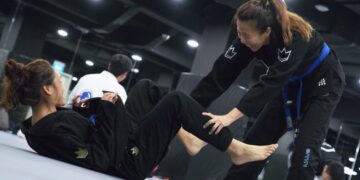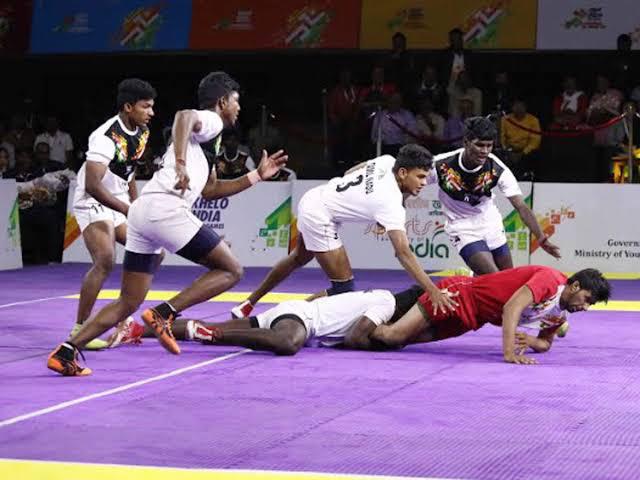
Many professional athletes incorporate swim training into their workout routines to take their training to the next level. Swim training pushes your lung capacity and muscle endurance, helping to build you into a more durable, explosive fighter.
This article will explore the benefits of swim training and how to get the most out of it as a martial arts fighter.
Why Fighters Hit The Water
Some of the reasons why swim training is so popular with fighters include:
- Offers Full-Body Resistance: Water provides 12-15 times more resistance than air, pushing your muscles in ways you don’t get during conventional workouts. Every movement recruits muscles in your shoulders, back, core, and legs in unison, just like a perfectly timed takedown or combination. Practicing fighting techniques underwater improves your intermuscular coordination more than above-water exercises because of the added resistance water provides.
- Improves Breath Control: Swimming styles like the butterfly teach you to inhale between strokes, which works your diaphragm and respiratory muscles harder than running sprints, boosting your total lung capacity and VO2 max by as much as 15–20 percent according to research.
- Provides Low-Impact Load: Swimming is a lot gentler on your joints than running on concrete or turf, allowing you to get more training done without stressing your ankles, hips, and knees. This makes swim-training ideal for recovery days when you still want to move without putting a significant load on your body. The low impact of swim training also makes it an excellent rehabilitation tool.
Boosting Your Lung Capacity
Swimming forces you to time every breath, training your respiratory pump to work under constraint. You’re less likely to gas out during fights when you regularly push your lungs to their limits during swim training.
Some of the ways swimming strengthens your respiratory system include:
- Increased Lung Volume: Intensive swim training increases your lung and heart volumes, improving your body’s ability to absorb oxygen.
- Higher VO2 Max: Athletes often see a 15–20 percent jump in VO2 max over several months of swim workouts.
- Fight-Specific Endurance: Taking in more air per breath allows you to go deeper into grappling scrambles or clinch exchanges without gasping.
Swimming Drills For Fighters
Now that we’ve covered some of the benefits of swim training, let’s explore some of the most popular drills for fights.
1) Controlled-Frequency Breathing Drill
- Warm Up: 100 m easy freestyle.
- Main Set: 4×50 m freestyle at a moderate pace.
- Laps 1–2: Inhale every 5 strokes
- Laps 3–4: Inhale every 7 strokes
- Rest: 30 seconds between repeats.
Waiting longer intervals to breathe while swimming trains your body to function more efficiently during low-oxygen windows, like the later rounds of a match.
2) Shoulder Durability Drill
Punch after punch and clinch after clinch, your shoulders take a hammering during fight training. Swimming offers low-impact resistance training that strengthens your rotator cuffs and scapular stabilizers through a full range of motion.
Some ways swimming increases shoulder endurance include:
- Scapular Stability: Water’s drag challenges the muscles around your shoulder blade, leading to more powerful strikes and control in grappling situations.
- Rotator-Cuff Balance: Targeted pool exercises correct the “push-heavy” imbalance most fighters develop from constantly engaging push-muscles like the triceps, chest, and shoulders while training. Research shows a 12-week swim-based program cut shoulder rotational imbalances by over 25 percent in athletes.
3) Underwater Shadowboxing
You’ve probably seen videos of fighters like Saul “Canelo” Alvarez shadowboxing while fully submerged. The resistance the water generates makes you work harder on every strike you throw, helping to increase power. You also get to increase your lung capacity while holding your breath underwater.
Start standing in chest-deep if you’re new to the exercise with your feet shoulder-width apart. You can try the exercise fully submerged once you can hold your breath underwater for more than 30 seconds. Shadowbox for three one-minute rounds with 30-second breaks in between.
4) Pool Sprints
Get into waist to chest-high and sprint for 20 seconds or as long as you can. Rest for the same amount of time and repeat a few more times. This exercise develops fast-twitch power and trains you to push through resistance, just like you do when breaking away from a clinch or fighting off an opponent trying to drag you to the ground.
Attach a swim parachute to your waist to take this exercise to the next level.
5) Pull-Buoy Arm Sets
Place a pull-buoy between your thighs and swim freestyle using only your arms. Aim for four laps with 30-second breaks between them. This exercise isolates your upper body, so your lats and shoulders build endurance for relentless punching.
6) Hypoxic Distance
Swim four laps across a pool freestyle while varying your breathing intervals. Breathe every 3 strokes during your first lap, every 5 strokes the next, every 7 strokes for the rest of your circuit. Rest for 30 seconds if you need a break between laps.
Limiting your breathing intervals during your laps trains your respiratory system to be more efficient under oxygen debt, improving your ability to keep fighting during the later rounds of fights.
Harness The Power Of Active Recovery
A cool-down session in a pool flushes out lactic acid from your muscles twice as fast as passive recovery, helping you to show up fresh for your next training session. It’s an excellent way to pamper sore legs or shoulders after intense training sessions. Swimming also reduces inflammation by as much as 14% compared to passive resting.
Here’s what a 20-minute active-recovery swim training looks like:
- 5 minutes easy backstroke.
- 10 minutes steady breaststroke or sidestroke.
- 5 minutes of gentle flutter-kick with a board.
- Keep effort at less than 60 percent of max heart rate. This is a recovery session, not a HIIT workout. Focus on enjoying the break away from intense training.
Swim-Training Makes You A More Durable Fighter
Swim training pushes your muscles and respiratory systems in ways you simply can’t above water, improving your endurance and ability to outgrind opponents during competitions. If you’re looking to take your cardio to another level, consider making swim-training an integral part of your fight training!
You may also like:
How To Improve Bone Density For Stronger Punches And Kicks
Intermittent fasting (IF) has been popular among martial arts fighters for decades, with legends like Georges St. Pierre swearing by its effectiveness. While the idea of skipping meals before intense training often sparks debate, this…
Many people think ripped muscles, lightning hand and leg speed, and perfect technique are the only things you need to develop knockout power in striking-based martial arts such as Muay Thai, Boxing, and Mixed Martial…
Flexibility plays a crucial role in how well you can execute many fighting techniques. For example, you need a certain level of hip flexibility to throw high kicks in Muay Thai or to use the…
Your isometric strength plays a role in martial arts like Brazilian Jiu-Jitsu, Wrestling, Boxing, and Muay Thai, whether you realize this or not. Anything that requires holding a position while fighting against tension and other…
Getting older doesn’t mean you have to hang up your gloves or retire your Gi in martial arts. While aging is inevitable, there are ways to keep dominating the mat, ring, and cage as your…
You’ve tried every diet there is out there: keto to force your body to use fat as its primary source of energy, intermittent fasting to improve testosterone production, even that questionable “caveman” phase where you…
You’ve probably heard that martial arts training builds character, discipline, and confidence, but did you know it can also help children with attention-deficit/hyperactivity disorder (ADHD) manage their symptoms? In a fast-paced, academically driven place like…
Nowadays, it’s common for teenagers to spend hours each day on electronic devices like smartphones, tablets, TVs, and gaming consoles. Most of them spend way more time staring at screens than they do on their…
Feeling a little anxious heading into your first sparring session in martial arts is perfectly normal. You’ve never had the chance to test your skills against resisting opponents, and you’re unsure about how well you’ll…
The cross is one of the most powerful punches in a boxer’s arsenal, and it also covers more distance than every other type of punch besides the jab. It’s an outside range weapon that can…
Brazilian Jiu-Jitsu is known for its highly technical ground game, but the truth is every match begins standing. Whether it’s a competition setting, a self-defense scenario, or an MMA fight, learning how to bring your…
In striking arts, size and reach are important tools, but they don’t guarantee success. When facing a smaller opponent, the challenge often lies in their speed, mobility, and ability to slip into range before you…


![[WATCH] IND vs SA 2025: Rishabh Pant vents frustration at Kuldeep Yadav for slow over-rate warning](https://lbsports88.com/wp-content/uploads/2025/11/watch-ind-vs-sa-2025-rishabh-pant-vents-frustration-at-kuldeep-yadav-for-slow-over-rate-warning-360x180.jpg)





























![[WATCH] IND vs SA 2025: Rishabh Pant vents frustration at Kuldeep Yadav for slow over-rate warning](https://lbsports88.com/wp-content/uploads/2025/11/watch-ind-vs-sa-2025-rishabh-pant-vents-frustration-at-kuldeep-yadav-for-slow-over-rate-warning-120x86.jpg)



![[WATCH] IND vs SA 2025: Rishabh Pant vents frustration at Kuldeep Yadav for slow over-rate warning](https://lbsports88.com/wp-content/uploads/2025/11/watch-ind-vs-sa-2025-rishabh-pant-vents-frustration-at-kuldeep-yadav-for-slow-over-rate-warning-350x250.jpg)